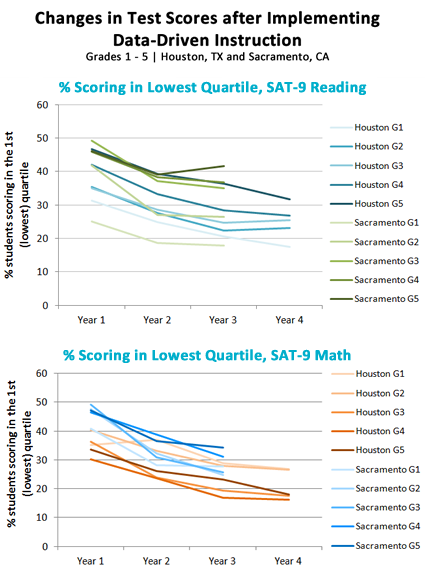What Is TSDS?
The Texas Student Data System (TSDS) is Texas's new education data collection and reporting system. It replaces an aging and inefficient system with one that is easier to use, more expandable, and more useful to districts. TSDS's main goal is to save districts and charter schools time and money, while dramatically increasing the timeliness and value of the data it returns to teachers and administrators.

The chart is based on a project funded by the Council of the Great City Schools, which explored how various districts in the US have produced measurable improvements in education outcomes by employing a suite of reforms that include extensive use of data-driven instruction.
The chart shows how the percentage of each LEA's students who scored in the lowest quartile on the SAT-9 declined substantially in the 3 years (Sacramento) or 4 years (Houston) since the reforms were implemented. The study concludes that a key component of these LEAs' success was that they "committed themselves to data-driven decision-making and instruction." (Snipes, J., F. Doolittle, and C. Herlihy. Foundations for Success: Case Studies of How Urban Schools Improve Student Achievement. New York: MDRC, 2002).
What Does It Do for Texas?
TSDS benefits the public in a number of ways:
(1) Reduces costs for taxpayers
TEA is able to provide the Education Data Warehouse (EDW) to local education agencies (LEAs—Texas school districts and charter schools) free of charge, thanks to federal and private grants. The public will also continue to benefit from free TPEIR reports that provide over 20 years of Texas education data.
(2) Improves PEIMS data quality
By making all submissions for the current school year open from the first day of school and offering a new client-side validation tool, TSDS will help improve the quality of the data collected for PEIMS.
(3) Contributes to an expanded P-20+ system
Selected PEIMS data is aggregated and rolled up to the public TPEIR site, where it becomes part of the state's newly expanded longitudinal data system, which tracks education data from preschool to the workforce.
(4) Improves education outcomes
The P-20+ data collection in TPEIR will help educators, administrators, researchers, and policy-makers develop more effective, better informed education practices and policies. This system's goal is to help educators help students.
Privacy
All TSDS systems are strictly HIPAA and FERPA compliant. Safeguarding sensitive data is a core commitment of this project as well as a legal mandate. Only authorized education staff can access this data, the purpose of which is to allow teachers to help students with greater precision. Some TSDS data is available to the public in anonymous, aggregated form through the TPEIR website.
Funding
This effort has largely been funded by grant money from the US Department of Education and from the Michael and Susan Dell Foundation. These grants have enabled TEA to build the TSDS platform, a statewide data store, and to incorporate seven data collections into the platform at no costs to the LEA's.
For More Information...
To learn more about the TSDS initiative:
- Explore the history of the TSDS initiative
- Learn more about Our Partners
- Visit us on Twitter (@teainfo) or on our Facebook page for the latest project updates

